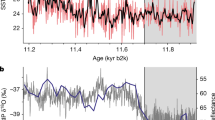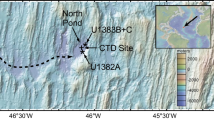Abstract
The research vessel Akademik Kurchatov has investigated the Red Sea rift zone with the aid of a manned submersible Pisces XI in the winter of 1979–80, as the value of such investigations is now well established1,2. Our research involved a comprehensive programme of hydrophysical studies in deeps containing thermal brines of the sea axial rift—Atlantis II, Discovery and Valdivia (see Fig. 1). Measurements were made with standard hydrographic stations, the AIST temperature and salinity meter with specially selected temperature and electric conductivity scales on board a towed vehicle Zvouk-4m, and Pisces XI. The present data on water stratification in the Atlantis II, Chain and Valdivia deeps have in general confirmed previously known data3–9 but have also revealed some new facts. For example, we have recorded an increase of temperature of the hot brine of up to 62 °C in the southwestern basin of the Atlantis II deep since studies aboard the R/V Sonne in 1977. Using data from this expedition, Hartmann9 gives a curve of temperature growth in the lower brine constructed from the data of different expeditions since 1965. A multilayer temperature structure of the upper brine and horizontal inhomogeneities have also been found8–10. Steps in the upper brine of the Atlantis II deep were first described6,9 from the surveys of the R/V Valdivia (1971–72) and Sonne (1977). Our observations reveal stratification of the deep brine (Table 1) in temperature and electrical conductivity (salinity) and enable their rate of change of thickness to be estimated10.
This is a preview of subscription content, access via your institution
Access options
Subscribe to this journal
Receive 51 print issues and online access
$199.00 per year
only $3.90 per issue
Buy this article
- Purchase on SpringerLink
- Instant access to full article PDF
Prices may be subject to local taxes which are calculated during checkout
Similar content being viewed by others
References
Riffaud, C. & Pichon, X.Le Expédition “Famous” (Albina Michel, Paris, 1976).
CIAMEX, EOS 59, 1198 (1978).
Voitov, V. I. Dokl. Akad. Nauk SSSR, 174, 1429–1431 (1967).
Bubnov, V. A. et al. Okeanologia, 17, 603–611 (1977).
Backer, H. & Schoell, M. Nature phys. Sci. 240, 153–158 (1972).
Schoell, M. in Proc. 2nd United Symp. on Development and Use of Geolhermal Resources, San Francisco (1975).
Degens, E. & Ross, D. Hot Brines and Recent Heavy Metal Deposits in the Red Sea. (Springer, Berlin, 1969).
Booker, H. Geol. Jb. 3–78 (1975).
Hartmann, M. Deep-Sea Res. 27 A, 161–171 (1980).
Monin, A. S., Plakhin, E. A. & Prokhorov, V. I. Dokl. Akad. Nauk. SSSR 254, 483–486 (1980).
Monin, A. S. et al. Dokl. Akad. Nauk SSSR 254, 1005–1009 (1980).
Monin, A. S., Plakhin, E. A. & Stunjas, P. A. Dokl. Akad. Nauk. SSSR 255, 458–462 (1980).
Author information
Authors and Affiliations
Rights and permissions
About this article
Cite this article
Monin, A., Plakhin, E., Podrazhansky, A. et al. Visual observations of the Red Sea hot brines. Nature 291, 222–225 (1981). https://doi.org/10.1038/291222a0
Received:
Accepted:
Issue date:
DOI: https://doi.org/10.1038/291222a0



